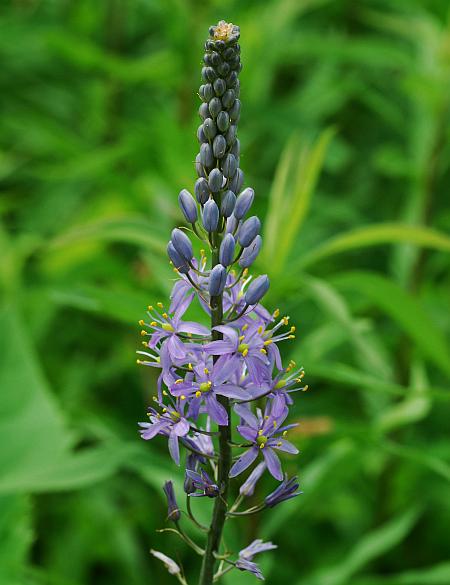Camassia angusta (Engelm. & A. Gray) Blank.
Wild Hyacinth, Prairie Camas

Native
CC = 10
CW = 5
MOC = 12
© SRTurner
Camassia angusta (Engelm. & A. Gray) Blank.Wild Hyacinth, Prairie Camas | |
 |
Native CC = 10 CW = 5 MOC = 12 |
© SRTurner |
|
Family - Liliaceae Habit - Perennial forb from a bulb, lacking allium odor.
Stems - Aerial stems erect, to 110 cm, terete, glabrous, with several (3-24) linear, bractlike leaves below the lowermost flowers.
Leaves - Mostly basal, glabrous, to 45 cm, linear and straplike, flat with a raised midrib on the lower surface, sometimes folded longitudinally in the basal portion. Stem leaves alternate, greatly reduced and bractlike.
Inflorescence - Terminal racemes of 50-100 flowers. Flowers stalks 5-30 mm long, subtended by linear, involute bracts.
Flowers - Perianth spreading, 7-10 mm long, the tepals free, pale lavender to pale purple. Stamens 6, free. Style 1, 2.5-5.5 mm long, the stigma 3-lobed. Ovary superior, with 3 locules, each with 2-5 ovules.
Fruits - Capsules, 6-10 mm long, ovoid to obovoid, erect or nearly so, the stalks 5-20 mm long, arched upward.
Flowering - May - June. Habitat - Mesic upland prairies and savannas, sometimes in rocky areas. Origin - Native to the U.S. Lookalikes - C. scilloides. Other info. - This species is much less common in Missouri than its close relative, C. scilloides. It occurs mostly in a cluster of counties in the southwestern part of the state, with a few other scattered populations elsewhere. Beyond Missouri the main populations occur in a band extending from eastern Kansas through central Texas. The plant is differentiated from its sibling C. scilloides by the presence of numerous linear, bractlike leaves along the upper stem below the inflorescence. In C. scilloides, these are absent or very few in number. Additionally, C. angusta blooms later and has more deeply colored flowers than C. scilloides. Photographs taken at Shaw Nature Reserve, Franklin County, MO, 6-3-2019 and 6-4-2021 (SRTurner). |